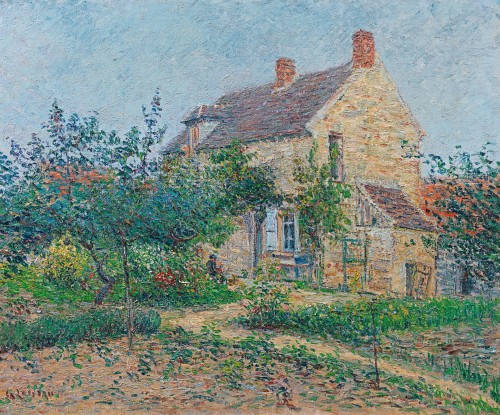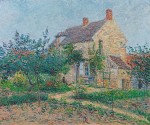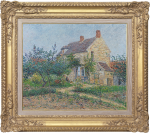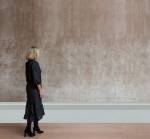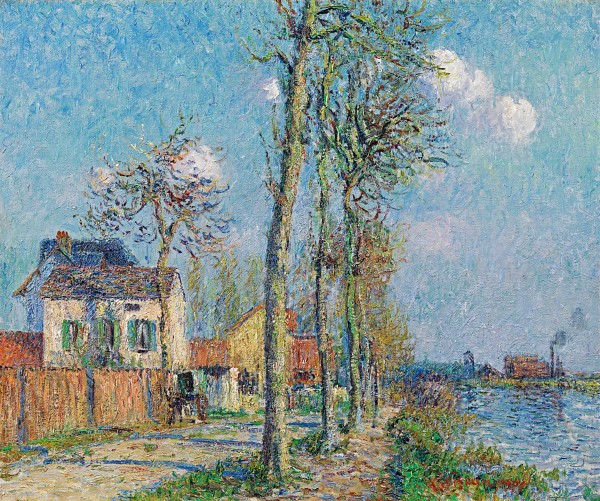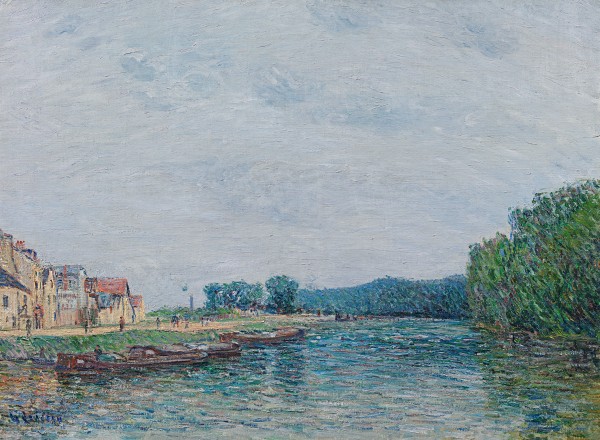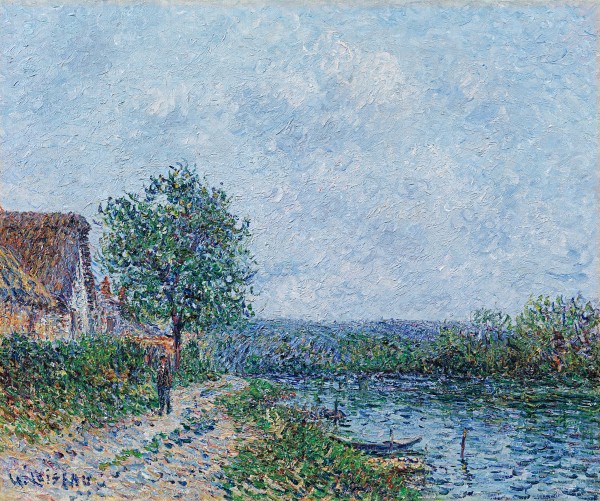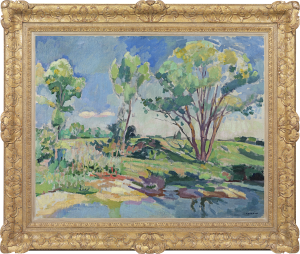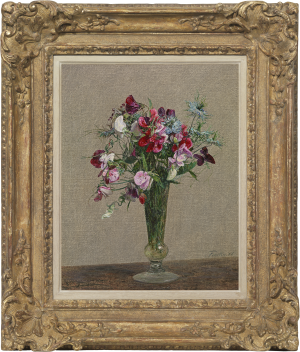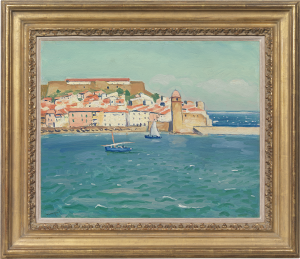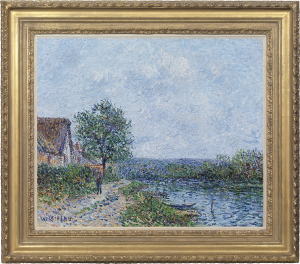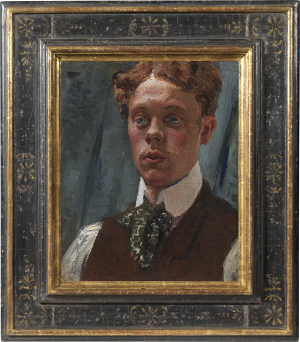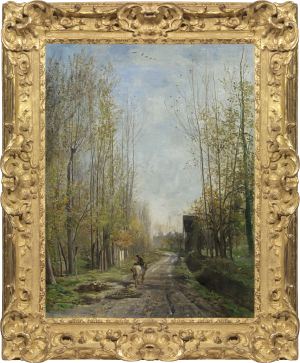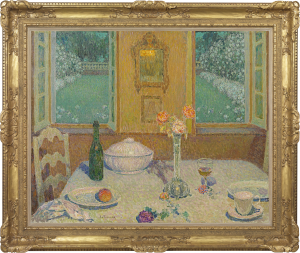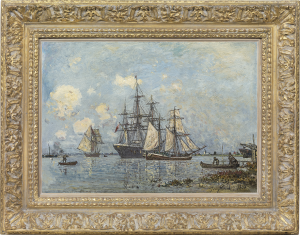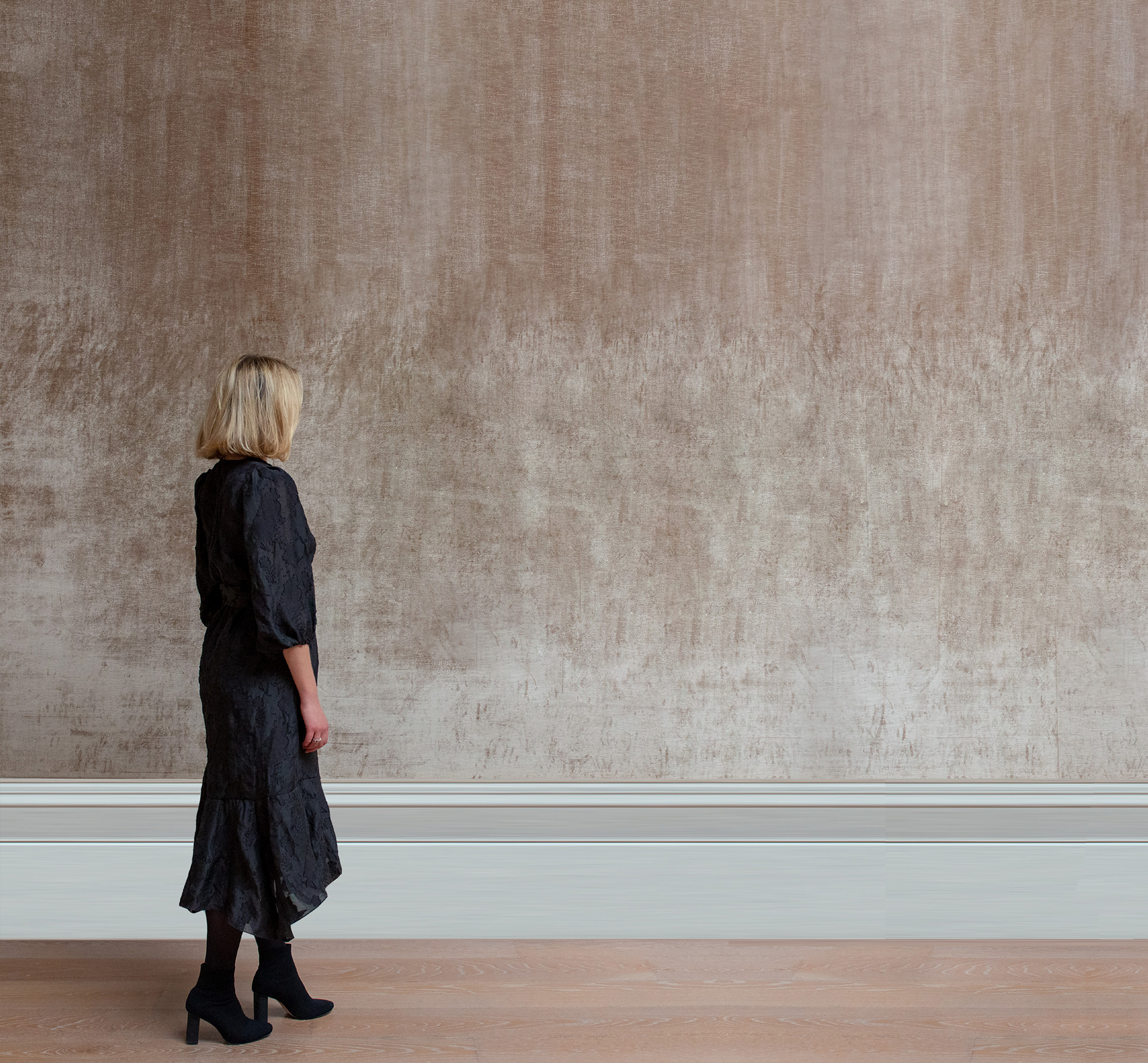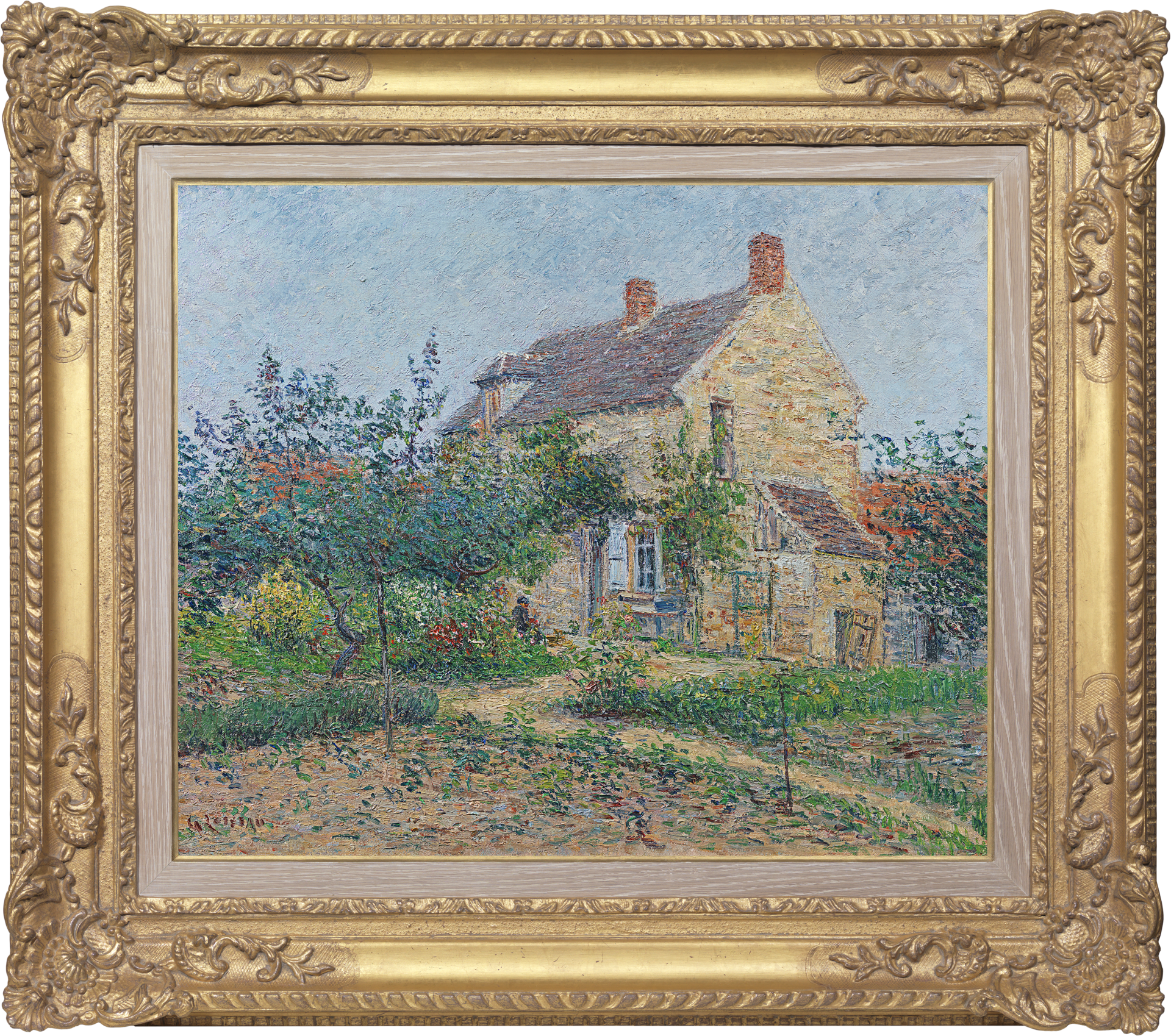Gustave Loiseau
La maison de la mère XIV, Nesles-la-Vallée
Oil on canvas: 22 x 26 (in) / 55.9 x 66 (cm)
Signed lower left: G. Loiseau
This artwork is for sale.
Please contact us on: +44 (0)20 7493 3939.
Email us
GUSTAVE LOISEAU
1865 - Paris - 1935
Ref: BZ 268
La maison de la mère XIV, Nesles-la-Vallée
Signed lower left: G. Loiseau
Oil on canvas: 22 x 26 in / 55.9 x 66 cm
Frame size: 31 ¼ x 36 in / 79.4 x 91.4 cm
In a Louis XIV style composition frame
Painted in 1898
Provenance:
Acquired from the artist by Galerie Durand-Ruel on 4th March 1899
Galerie Durand-Ruel, Paris, 26th May 1931
Acquired on 26th January 1939 by Mrs Diane Watson, London
Arthur Tooth and Son, London
Private collector, UK, by descent from their grandparents
Exhibitions:
St Petersburg, Russia, Exposition Française des Beaux-Arts et des Arts Décoratifs, 1st January-1st February 1899, no.199
Mulhouse, Société des Arts, Exposition de la Société des Arts de Mulhouse, 1st January-1st April 1902, no.230
Dieppe, June-October 1902
Mairie de Maçon, Exposition des Beaux-Arts, 1st July-1st August 1903
To be included in the catalogue raisonné of the work of Gustave Loiseau being prepared by Monsieur Didier Imbert, ref. no.Fi 29 C 1004
Like many French artists, Gustave Loiseau divided his life between a studio in Paris, necessary for meeting dealers and colleagues and attending exhibitions, touring in search of new motifs, and spending time in a part of the country with familial associations. For Loiseau, this was Pontoise, on the river Oise about twenty-two miles north-west of Paris. Loiseau’s father, a butcher, had moved to the Ile-Saint-Louis in the centre of the capital in 1870, when Gustave was five. His parents retired and moved back to Pontoise a decade later, allowing Loiseau to explore the gentle, fertile rural landscape around the town, which had provided such a rich fund of subjects for Camille Pissarro when he lived there in the 1870s and early 1880s.
This painting depicts a dwelling at Nesles-la-Vallée, a village about five miles north-east of Pontoise. Embowered in a mature kitchen garden, the house exudes the air of rural wellbeing found in the Pontoise and Eragny paintings of Pissarro. The mellow, golden stone of the house is softened by creepers; a colourful flower bed is shaded by fruit trees. The warm, sandy earth of the foreground holds the neat rows of the potager.
The work was made in 1898, the year after a contract with Paul Durand-Ruel, champion of the Impressionists and their followers, gave Loiseau the financial freedom to concentrate on his landscape painting and travel extensively to find new motifs. He builds up the canvas in tiny, juxtaposed touches of colour, a method which owes more to the Impressionism of Pissarro and Monet than to the Pointillists with whom Loiseau briefly flirted. His subtle response to the qualities of light proclaims his love of painting en plein air, seeking to evoke an atmosphere beyond the mere observation of a fleeting moment in nature. His biographer Thiébault-Sisson explained his working methods: ‘After sketching in the outlines, [Loiseau] covered his canvas with soft, thick daubs, and when the paint was thick enough, he made the whole thing vibrate by adding little flecks of colour in all directions’[1]. The luminosity in this work is achieved with a ground tone of gold and pale ochre which lights up the stone of the house, the bare earth and sandy paths. The composition is given structure by bold diagonals of deep green, from the border vegetation to the line of the gnarled fruit trees. Deep emerald leaves are fretted against brilliant orange outhouse roofs, while the tangle of flowers by the house – rapid dabs of red, yellow and pink – waft an air of contentment and security in this little corner of the Ile de France.
The title of the painting, La maison de la mère XIV, Nesles-la-Vallée, was that given to it by Loiseau when Durand-Ruel acquired it in 1899; it is not clear whether the house is that of Loiseau’s own mother[2].
GUSTAVE LOISEAU
1865 – Paris – 1937
Gustave Loiseau is one of the most poetic and sensitive of the Post-Impressionists. His work shows the influence of Impressionist masters such as Alfred Sisley and Camille Pissarro and he briefly took advice from Paul Gauguin, whilst being a great admirer of Corot. Loiseau experimented with Pointillism, but developed his own style. He is considered to be a pure landscape artist, painting from direct observation of nature in a manner which is reminiscent of Claude Monet.
Loiseau was born in Paris, the son of a butcher from Pontoise who had moved to the Ile-Saint-Louis. He was apprenticed in 1880 to a painter and decorator, a job which he despised, but which confirmed his interest in art. Loiseau discovered the countryside of Pontoise when his parents retired there in 1881; a small legacy from his grandmother in 1887 spurred him to devote his life to landscape painting.
Loiseau studied at the Ecole des Arts Décoratifs and in 1889 at the studio of the landscape painter Fernand Quignon. Loiseau rented a room in a workers’ tenement, La Maison du Trappeur in the Rue Ravignon, Montmartre, which was later to become famous as the Bateau-Lavoir. He became acquainted with Jean-Louis Forain and Adolphe Willette, but his shy, nature-loving personality had little in common with the raucous bohemians of the Parisian art scene. In 1890 he went to Pont-Aven, staying at the famous inn run by Marie-Jeanne Gloanec, where he was befriended by Henry Moret and Maxime Maufra. Although working in a personal style, Loiseau’s paintings from this period show the influence of the Pont-Aven School in their diagonal compositions, shortened perspectives and anti-panoramic fields of view. Returning to Paris in 1891, Loiseau exhibited for the first time at the Fifth Exhibition of Impressionist and Symbolist Painters. He showed paintings at the gallery of Le Barc de Boutteville in Rue Le Pelletier, where two works were bought by the celebrated Rouen collector and friend of Monet, François Depeaux.
For much of his life Loiseau was based in Paris but travelled extensively through France, making repeated trips to Pont-Aven, where he was encouraged by Gauguin in 1894, to Normandy and to Pontoise. Described as ‘the historiographer of the Seine’, he also captured the shifting moods of the Oise and the Eure rivers and the Channel ports. Loiseau joined the Société des Artistes Indépendants in 1893. In 1897 he signed an agreement to sell most of his output to Paul Durand-Ruel, giving him the financial independence to travel more extensively. Loiseau divided his last years between Pontoise (where he is buried) and Paris, where he died in 1935.
The work of Gustave Loiseau is represented in the Musée d’Orsay, Paris; the Musée des Beaux-Arts, Rouen; the Ashmolean Museum, Oxford; the Marubeni Collection, Japan; the Metropolitan Museum of Art, New York; the Museum of Fine Arts, Boston and the Nelson-Atkins Museum of Art, Kansas City.
[1] Thiébault-Sisson, Gustave Loiseau, Paris 1930, quoted in Judy Le Paul, Gauguin and the Impressionists at Pont-Aven, New York 1987, p.192.
[2] Information kindly given by Monsieur Didier Imbert.

